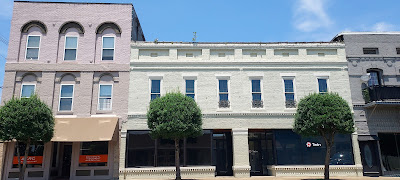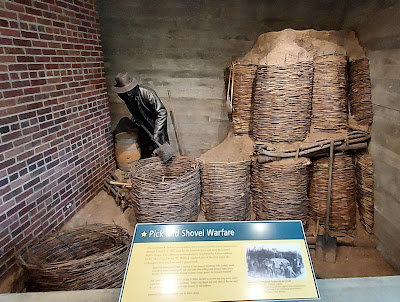Our next destination was Pickwick Campground in Pickwick, TN, located near the Dam and the hydroelectric plant developed by the Tennessee Valley Authority along the Tennessee River. Beautiful campground with HUMONGOUS sites, big enough to leave Big Boomer and Suite Retreat hitched and still fit the Rambling RV Rat Pack Rubicon on site rather than in overflow parking. Water, electric hookups and dump station for $35.50/night.
 |
| Pickwick Dam, Bridge, and Powerplant. |
 |
| The Tennessee River View from Pickwick Campground. |
 |
| Our humongous site! |
Though accessibility within the Campground was good, getting to the Campground immediately after crossing the Pickwick Dam Bridge was another story. We retired our old GPS Gerda and purchased Gretchen a few years ago thinking Gretchen’s brain was sharper than old Gerda’s. As the late comedian, John Pinette, would say, “nay nay”. Gretchen is set up for the truck/RV combo. Regardless, she instructs us to approach the Campground via a series of switchbacks, on the downward slope of a hill, with heavy oncoming traffic. Tight, tight, tight to say the least. (Having learned the lay of the land, we ignored Gretchen when we departed the Campground and bypassed the switchbacks entirely.)
There is a stench in the Campground that smelled familiar. Locals attribute it to the chemical process used by the huge paper/packaging plant nearby. (Ah, that is why I recognized it—we were repulsed by the same odor produced by the paper plant along the Mississippi River when we were in Grand Rapids, MN in 2022!)
It was already
3 p.m. by the time we finished set-up, but we decided to go anyway to Shiloh
National Military Park and began our touring.
If nothing else, we could take in
the film at the Visitor Center.
 |
| Shiloh National Military Park Visitor Center/Bookstore. |
 |
| A small sampling of some of the monuments... |
 |
| ...throughout the Military Park grounds. |
 |
| Confederate monument at Shiloh. It has 11 figures on it (front and back), representing the 11 Confederate states. |
Please remember as you read this blog, I am providing an abridged version of Civil War events, for I am neither a historian nor a War buff. I am just a cotton-brained stuffed rat who loves to travel, learn, and ramble! So...
The Union
war plan was to impede the railroad supply lines and control the waterways that
linked 2 halves of the Confederacy. The
battles of February 1862 at Fort Henry (along the Tennessee River) and
Fort Donelson (along the Cumberland River) were the first two Union
victories towards this goal. The outcome
of the Battle of Shiloh was an important one.
If the Union was victorious, it would gain strategic hold of the
Tennessee River.
The Confederates attacked the Union in the pre-dawn hours of April 6, 1862. It was crucial they made this move before more Union troops arrived at Pittsburg Landing. The attack was successful, and Union lines were pushed back. But this initial success came with a high price tag—the life of Confederate General Albert Sidney Johnston, who was the highest ranked U.S. military officer killed in action during the Civil War.
But things
change rapidly on a battlefield. With
General Johnston’s passing, General Beauregard became Commander. On April 7, Grant’s army received
reinforcements. The Confederate gains
from April 6 were negated, and they were pushed back to Shiloh Church. (It is after this Methodist
log Church that the battle was named.) The
Union was saved from defeat, and Beauregard ordered his Confederate troops to
retreat to Corinth.
 |
| Pittsburg Landing along the Tennessee River. |
 |
| We visited all of the Confederate mass graves within the battlegrounds. Pictured is just 1 of 5 such sites. |
 |
| Duncan's Farm, location of some of the worst fighting during the Battle of Shiloh. |
 |
| If the walls of Widow Sarah Bell's home could talk! Fighting took place twice on this property, which was once peach orchards, fields, and woods. |
Including both
Union and Confederate States of America troops, the Battle of Shiloh involved
111,501 men. Casualties were high--more
than 20% dead, missing in action, prisoners of war, injured/wounded. Interestingly, it was at the Battle of Shiloh
that John Wesley Powell, known predominantly for his Colorado River/Grand
Canyon expeditions, lost his arm at age 28.
He was struck by a Minnie ball when giving the order to fire at
Pittsburg Landing.
After touring the Military Park, we walked reverently through Shiloh National Cemetery and the Shiloh Indian Mounds National Historic Landmark, the latter of which represents the village of indigenous peoples who inhabited this area’s bluffs above the Tennessee River for more than 300 years from approximately 1000 AD.
 |
| Squirrel sitting on one of the headstones. |
 |
| The tall marker on the right indicates where General Grant's Shiloh headquarters were located. |
 |
| The bluff overlooking the Tennessee River on which the mounds are located. |
 |
| Sunset from Shiloh National Military Park. |
We began our
tour of Corinth the next day at the Interpretive Center.
Its walkway from the parking lot to the front door is long and contains
a series of switchbacks. It seemed weird
to me at first. Then I realized it is an
exhibit, and a unique one at that! With
casts of rifles, hats, belts, and buckles along the path, it emulates how a
soldier would run in retreat to avoid enemy fire (zig zag) and what
would be left behind (assorted gear), either by accident or purposely to
lighten his load.
We watched the film and perused the exhibits that educated me about the Siege and Battle at Corinth.
While the North had an interconnected railway/waterway system, The South had small, independent rail lines: Gulf Mobile & Ohio ran South to North, and Memphis & Charleston ran West to East. Corinth (originally called Cross City) is where these lines intersected. Obviously, it was vital for the Confederates to maintain control of Corinth, whose railways provided vital supplies and connected the South to Atlantic coastal waterways.
With Confederate
General Beauregard’s retreat from Shiloh and Union armies staged nearby, the
region around Corinth in May 1862 held nearly a quarter million military
personnel. Eventually, only 70,500
troops stayed in Corinth, but this still created a burden on the resources
available in a town with only 1,500 residents (of which 400 were slaves).
Confederate
soldiers were suffering from disease, hunger, and contaminated water. (It was said more Confederates died in
Corinth from these conditions than from battle in Shiloh). Furthermore, Union troops were making
positional gains towards Confederate lines in Corinth. Confederate General Beauregard decided it was
best to retreat. However, he didn’t want
to tip his hand. So, he ordered empty
train cars to come to Corinth. His sick/injured troops, heavy artillery, and
supplies were put on the trains, but the Union most likely would believe the
trains were discharging Confederate reinforcements. Hoping the Union would think Confederate
artillerymen were still in positions at their fortifications, Beauregard
ordered his men to chop trees and place them as if they were cannons. In reality, Beauregard and his forces were
heading South to Tupelo, MS on May 29, 1862, leaving Corinth behind for Union
occupation.
But the
Confederate States of America were not giving up. On October 3, 1862, Major General Van Dorn,
in an effort to retake Corinth, attacked Union forces using a wide arc between
and around both railways. The
Confederates were able to breach Federal lines, driving Union Major General
Rosecrans and his troops south toward town.
House-to-house combat ensued (a rare occurrence throughout the Civil
War). Long story short, the
Confederates were unsuccessful in their efforts and again were forced to
retreat. Corinth would represent the Confederacy’s
last offensive in Mississippi. Now Major General Grant and Union forces could
focus on capturing Vicksburg and gaining control of the Mississippi River.
With Corinth fully in Union control, many escaped slaves converged there seeking refuge. However, they were not freed yet. Instead, they were deemed “contraband” of war. So, the Union built a Contraband Camp in Corinth. It started as a tent city, but it eventually contained housing structures, a school, church, and hospital. We visited the Camp. However, no structures exist any longer. Instead, bronze statues depict the formerly enslaved people who inhabited the Camp. They were offered religious, academic, and vocational instruction and were given paid jobs. Many even joined the military efforts of the Union.
Whew! We spent the whole day in Corinth. To immerse ourselves, we drove and walked to visit as many sites of battle lines and earthen fortifications as possible (we had to forego some since they were located on private properties).
 |
| Field where fighting occurred. |
 |
| An earthen fortification. |
 |
| We walked more than a mile round trip... |
 |
| Battery F is supposedly the best preserved redoubt from the Battle of Corinth on October 3, 1862. |
We viewed the intersecting train tracks of the two railways, visited the Corinth National Cemetery, and we took a walking tour in the historic district. With some buildings dating to the1830s, we got a sampling of antebellum Corinth.
 |
| The railroad crossroads. |
 |
| The drug store dates to the 1830s. |

We are taking a hiatus from touring Civil War battlefields. We will resume visiting more of them later in the summer. Next up: The Land of Lincoln, Springfield, IL.
Talk to you
again soon!























We also enjoy learning about historical events and touring old battlefields. Safe travels!
ReplyDelete